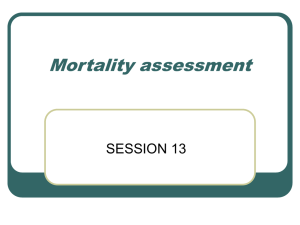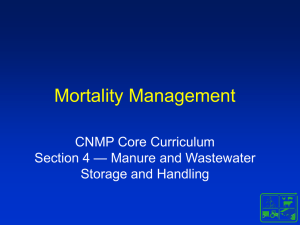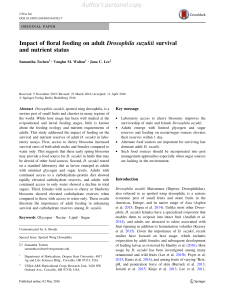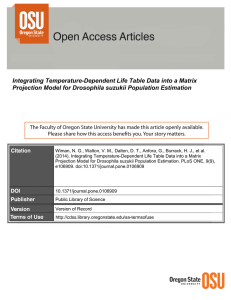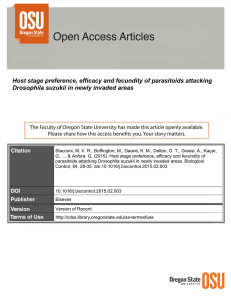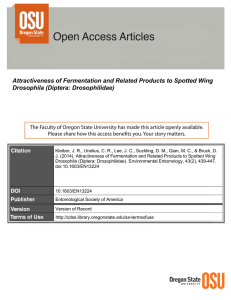2011 ESA Pacific Branch Meeting
advertisement
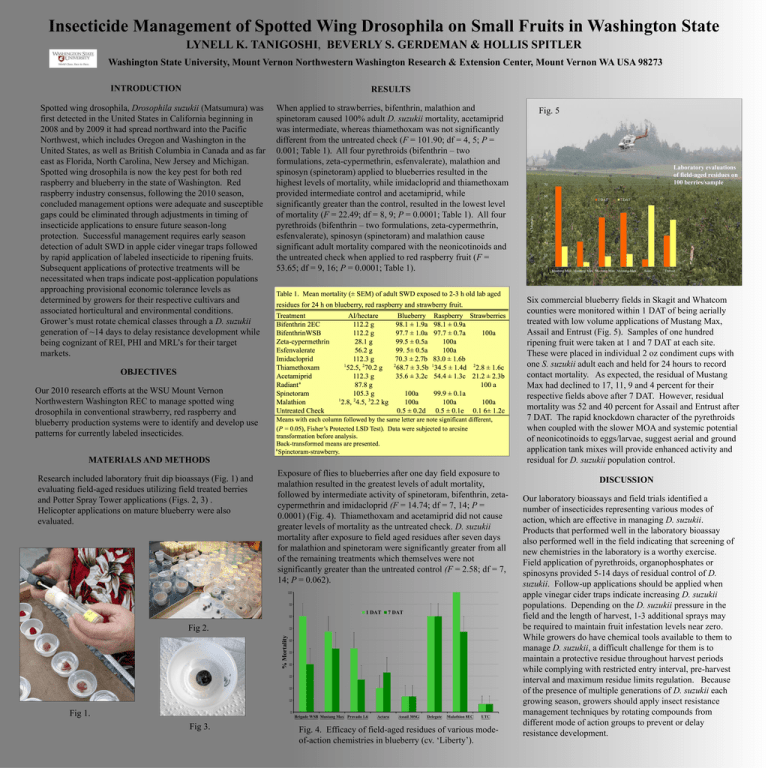
Insecticide Management of Spotted Wing Drosophila on Small Fruits in Washington State LYNELL K. TANIGOSHI, BEVERLY S. GERDEMAN & HOLLIS SPITLER Washington State University, Mount Vernon Northwestern Washington Research & Extension Center, Mount Vernon WA USA 98273 INTRODUCTION RESULTS When applied to strawberries, bifenthrin, malathion and spinetoram caused 100% adult D. suzukii mortality, acetamiprid was intermediate, whereas thiamethoxam was not significantly different from the untreated check (F = 101.90; df = 4, 5; P = 0.001; Table 1). All four pyrethroids (bifenthrin – two formulations, zeta-cypermethrin, esfenvalerate), malathion and spinosyn (spinetoram) applied to blueberries resulted in the highest levels of mortality, while imidacloprid and thiamethoxam provided intermediate control and acetamiprid, while significantly greater than the control, resulted in the lowest level of mortality (F = 22.49; df = 8, 9; P = 0.0001; Table 1). All four pyrethroids (bifenthrin – two formulations, zeta-cypermethrin, esfenvalerate), spinosyn (spinetoram) and malathion cause significant adult mortality compared with the neonicotinoids and the untreated check when applied to red raspberry fruit (F = 53.65; df = 9, 16; P = 0.0001; Table 1). Our 2010 research efforts at the WSU Mount Vernon Northwestern Washington REC to manage spotted wing drosophila in conventional strawberry, red raspberry and blueberry production systems were to identify and develop use patterns for currently labeled insecticides. MATERIALS AND METHODS Exposure of flies to blueberries after one day field exposure to malathion resulted in the greatest levels of adult mortality, followed by intermediate activity of spinetoram, bifenthrin, zetacypermethrin and imidacloprid (F = 14.74; df = 7, 14; P = 0.0001) (Fig. 4). Thiamethoxam and acetamiprid did not cause greater levels of mortality as the untreated check. D. suzukii mortality after exposure to field aged residues after seven days for malathion and spinetoram were significantly greater from all of the remaining treatments which themselves were not significantly greater than the untreated control (F = 2.58; df = 7, 14; P = 0.062). 100 90 80 Fig 2. 1 DAT 7 DAT % Mortality 70 60 50 40 30 20 10 Fig 1. 0 Brigade WSB Mustang Max Provado 1.6 Fig 3. Laboratory evaluations of field-aged residues on 100 berries/sample 70 60 1 DAT 7 DAT 50 40 30 20 10 0 Mustang Max Mustang Max Mustang Max Mustang Max Assail Entrust Six commercial blueberry fields in Skagit and Whatcom counties were monitored within 1 DAT of being aerially treated with low volume applications of Mustang Max, Assail and Entrust (Fig. 5). Samples of one hundred ripening fruit were taken at 1 and 7 DAT at each site. These were placed in individual 2 oz condiment cups with one S. suzukii adult each and held for 24 hours to record contact mortality. As expected, the residual of Mustang Max had declined to 17, 11, 9 and 4 percent for their respective fields above after 7 DAT. However, residual mortality was 52 and 40 percent for Assail and Entrust after 7 DAT. The rapid knockdown character of the pyrethroids when coupled with the slower MOA and systemic potential of neonicotinoids to eggs/larvae, suggest aerial and ground application tank mixes will provide enhanced activity and residual for D. suzukii population control. OBJECTIVES Research included laboratory fruit dip bioassays (Fig. 1) and evaluating field-aged residues utilizing field treated berries and Potter Spray Tower applications (Figs. 2, 3) . Helicopter applications on mature blueberry were also evaluated. Fig. 5 % Mortality Spotted wing drosophila, Drosophila suzukii (Matsumura) was first detected in the United States in California beginning in 2008 and by 2009 it had spread northward into the Pacific Northwest, which includes Oregon and Washington in the United States, as well as British Columbia in Canada and as far east as Florida, North Carolina, New Jersey and Michigan. Spotted wing drosophila is now the key pest for both red raspberry and blueberry in the state of Washington. Red raspberry industry consensus, following the 2010 season, concluded management options were adequate and susceptible gaps could be eliminated through adjustments in timing of insecticide applications to ensure future season-long protection. Successful management requires early season detection of adult SWD in apple cider vinegar traps followed by rapid application of labeled insecticide to ripening fruits. Subsequent applications of protective treatments will be necessitated when traps indicate post-application populations approaching provisional economic tolerance levels as determined by growers for their respective cultivars and associated horticultural and environmental conditions. Grower’s must rotate chemical classes through a D. suzukii generation of ~14 days to delay resistance development while being cognizant of REI, PHI and MRL’s for their target markets. Actara Assail 30SG Delegate Malathion 8EC UTC Fig. 4. Efficacy of field-aged residues of various modeof-action chemistries in blueberry (cv. ‘Liberty’). DISCUSSION Our laboratory bioassays and field trials identified a number of insecticides representing various modes of action, which are effective in managing D. suzukii. Products that performed well in the laboratory bioassay also performed well in the field indicating that screening of new chemistries in the laboratory is a worthy exercise. Field application of pyrethroids, organophosphates or spinosyns provided 5-14 days of residual control of D. suzukii. Follow-up applications should be applied when apple vinegar cider traps indicate increasing D. suzukii populations. Depending on the D. suzukii pressure in the field and the length of harvest, 1-3 additional sprays may be required to maintain fruit infestation levels near zero. While growers do have chemical tools available to them to manage D. suzukii, a difficult challenge for them is to maintain a protective residue throughout harvest periods while complying with restricted entry interval, pre-harvest interval and maximum residue limits regulation. Because of the presence of multiple generations of D. suzukii each growing season, growers should apply insect resistance management techniques by rotating compounds from different mode of action groups to prevent or delay resistance development.






